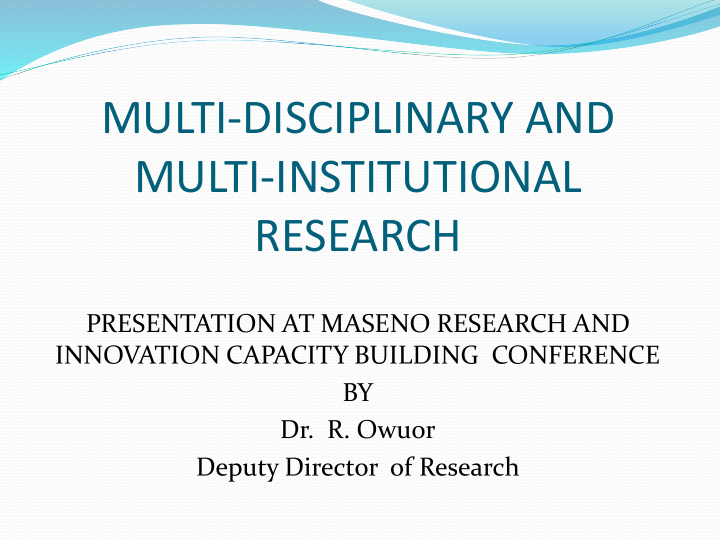



MULTI-DISCIPLINARY AND MULTI-INSTITUTIONAL RESEARCH PRESENTATION AT MASENO RESEARCH AND INNOVATION CAPACITY BUILDING CONFERENCE BY Dr. R. Owuor Deputy Director of Research
OUTLINE Introduction GoK support for Research Categories funded by GoK Why multi-disciplinary and multi-institutional Research What to consider in Multi-disciplinary and multi- institutional research What has been funded Conclusion
Introduction It has been evidenced globally that knowledge based economies are driven by well funded and structured research and innovation systems Article 11(2) of the Constitution emphasizes that the State shall: recognize the role of science and indigenous technologies in the development of the nation promote the intellectual property rights of the people of Kenya Article 33 (1) (c) on freedom of expression acknowledges academic freedom and freedom of scientific research
Cont. Science, Technology and Innovation Policy encourage entrenchment of product oriented multi-disciplinary approach to R&D Science, Technology and innovation Act, 2013 is in place to harmonize the application of research, science, technology and innovation towards the realization of development agenda
Cont. NACOSTI, KENIA and NRF work with all stakeholders in the Government, research institutions, private sector and academia in order to transform Kenya from a factor-driven economy into an innovation-driven economy.
GoK support for Research 2016/2017 2015/2016 KES 3B KES 497M 2008/2009 KES 250M
Cont. Financial 2014/2015 2015/2016 2016/2017 2017/ 2018/ Year (FY) 2018 2019 Research 379M 497M 3B 2.7B 1.84B Fund
Cont. The growth in funding shows positive trend towards attaining the set target for national research, ST&I funding of 2% of GDP as stipulated in the ST&I Act, 2013. Challenges of government Funding Limited resources Competition among institutions in the same sector Natural calamities such as floods
Funded area The funded research address the following areas: a) Sustainable development goals which can be divided into 5 groups namely: 1. Human Rights Justice (16), Equity (10), Gender (5)
Cont. 2. Economic Development Employment (8), Trade (12), Cities (11), Infrastructure (9) 3. Environmental development Energy (7), Climate change (13), Oceans (14), Ecosystems (15) 4. Social development Poverty (1), Hunger (2), Water (6), Health (3), Education (4) 5. Global Partnership (17)
Cont. b) Science, Technology and Innovation Strategy for Africa (STISA) -2024 This Strategy aims at accelerating Africa’s transition to an innovation led, knowledge based economy The sectors targeted are: Agriculture, health, infrastructure, mining, security, water, energy and environment The priorities are: eradication of hunger and food security, prevention and control of diseases, communication, protection of space, build society and generation of health
Cont. c) National priorities found in Kenya Vision 2030 Agriculture and rural development, tourism, manufacturing, financial services, health and life sciences, housing, trade and industry, human resource development, physical infrastructure, energy, environment and natural resources management, space science technology 4. “The Big Four”’Agenda Manufacturing, Affordable Housing, Food security and improved nutrition and Health
Categories funded by the Government of Kenya Postgraduate Multidisciplinary and Multi-institutional Research Infrastructure Support Bilateral and Multilateral Support Innovations Conferences, Workshops and Seminars
Why multi-disciplinary and multi- institutional research Break silo mentality Promote public private partnership Share available research facilities Capacity building
What to consider in multi-disciplinary and multi- institutional research • Research to focus on the national priority area Scientific excellence Novelty Importance Feasibility • Objectives to be SMART
Cont. Methodology and analytical approach should be explained clearly Methods and techniques employed should be appropriate Potential impact of the research Budget to be aligned to the activities Justification of the budget
Cont. The following should not be included in the budget: administrative cost salaries lease of offices purchase of laptops Purchase of desktops payment of fees for postgraduate students
Proposals received in 2016/2017FY PhD Msc./MA MMC Infrastructure Proposals 439 396 511 117 received Proposals 24 17 11 0 rejected at screening Reviewed 415 379 500 117 proposals Proposals 207 192 170 58 recommended for funding
Reviewed proposals in 2016/2017 FY Discipline PhD Msc./MA MMC Agric. 74 69 191 Health 64 74 165 Environment 42 22 52 Social 86 43 48 Physical Sciences 103 101 36 Biological 46 70 8 Sciences Proposals 415 379 500 Reviewed
Projects funded in 2016/2017 FY Category No. Multidisciplinary and 158 multi-institutional Research PhD Projects 202 Msc./MA Projects 185 Infrastructure 21
Proposals received in 2017/2018FY PhD Msc./MA MMC Proposals 662 466 801 received Proposals 247 220 444 recommended for funding
Projects funded under ‘Big 4’ Agenda Resear earch h Theme Collabor laboration ation Partn tner ers No. of Projec ojects ts Funded ded Funds ds Inves ested ted (Kshs) involv olved ed Non Communicable UK Government 8 17,414,737 diseases Food Security Several Europe 21 64,161,086 Countries Capacity building Germany 54 68,000,000 Kenya/German PhD Scholarships Manufacturing East Africa Countries 2 1,000,000 Health Research Kenya/South Africa 27 58,220,000 Research Infrastructure Kenya Universities and 16 783,148,764 Research Organizations Multidisplinary Kenyan Universities 20 252,940,654 Research Projects and Research supporting the Big 4 Organization Agenda National Capacity Kenyan Universities 30 104,380,430 Building PhD Programs and scientists
Conclusion The Team should agree on the following: Roles of the collaborators Mode of disbursement of funds to the collaborators from the other institutions during the implementation of the project Preparation of the progress and end of project reports IP management
THANK YOU
Recommend
More recommend